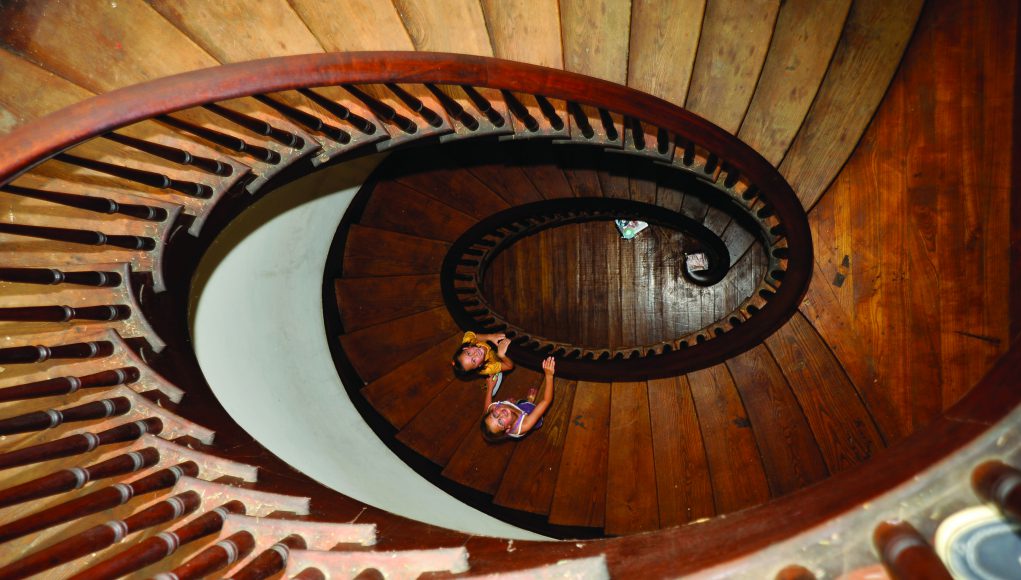If these walls could talk: Historic Homes in the Bluegrass
By Lisa R. Kindel
History built Lexington from its settlement in 1775 from a campsite at McConnell Springs to its evolution as the “Athens of the West.” Touring some of our region’s historic homes and gardens, you can see elegant architecture and gardens all over the Bluegrass with examples of Greek/Italianate, Federal, Georgian and Gothic architectures in Paris, Richmond, Lexington, Georgetown, and Danville. The homes provide a glimpse of Lexington’s historic impact as an intellectual, agricultural, political and religious epicenter for Kentucky.
Brittney Adams and husband Nick decided to “do something crazy,” as she describes their decision to buy Warrenwood Manor, restore it, start a business, and expand their cattle farming operation. “Many of the original features of the home are intact and more of the story surrounding the home is revealed every day,” she says.
Just south of downtown Danville, John Fourch Warren and his brother, Samuel Wilcox Warren built their Gothic Villa, Warrenwood Manor after their father, Captain William Warren, bought the 100+ acres in 1785. Warrenwood Manor was modeled after John McMurtry’s Gothic Revival Elley Villa on Linden Walk near UK’s campus. Lumber used in building Warrenwood came from the acreage it sits on and bricks were fired on property as well. The interior includes Venetian leaded glass windows, handcrafted bannisters and large mantels that complement its surroundings.
Brittney and Nick Adams have 800+ cattle, 11 chickens, two cats and a dog, and hosted their own wedding at the site, renovating the barn, and creating the wedding decor. One hundred and fifty guests gathered at the barn on October 11, 2014 for the wedding, followed by a reception that included beef jerky and popcorn, and then hot dogs and s’mores with friends and family. The two then went on a “Kentuckymoon” that included the Louisville Slugger museum, Cumberland Falls, stops along the Kentucky Bourbon Trail, a stop at a John Deere tractor store, Lake Barkley, Mammoth Cave, and Chaney’s Dairy.
They have blogged about historic home restoration, and blog readers get to help vote on colors (for example, for the recent bathroom renovation).
Warrenwood Manor was profiled in a January Huffington Post blog, “Five Lessons from an Old House,” (“be patient with the elderly; know thyself, know thy house; do your research, but don’t be a know-it-all; set a budget and then set it again; and utilize contractors selectively.”)

Less than 30 minutes from Hamburg, sits Paris and one of the oldest structures in Kentucky, Duncan Tavern. Built in 1788 by Major Joseph Duncan, a decorated major during the Revolutionary War, he created his post-colonial American home with “five windows on the second floor (facing the street) with a door in the middle on the first floor, two windows on either side” according to Duncan Tavern Historical Center’s Resident Curator, Judy Sieweke. Then Major Duncan saw the need for an inn for travelers passing through the area in 1795 and such historic figures as Daniel Boone and Simon Kenton stayed at newly christened Goddess of Liberty Inn. Today, Duncan Tavern houses the Daughters of the American Revolution as well as the John Fox, Jr. Genealogical Library, an extensive historical resource for those researching their family lineage.
Down I-75 in Richmond, Cassius Marcellus Clay made his home at White Hall, which started out as a completely different style of home. Initially, Clay’s father, General Green Clay, built Clermont in 1799, reflecting Georgian architecture, popular in the late 18th century. In 1860s, Cassius Clay remodeled the home into the Italianate/Greek Revival home that became White Hall. Young Clay’s crusade against slavery began after witnessing a tragic incident involving a slave named Mary and the Clay family’s abusive overseer. “The Lion of White Hall” started his newspaper True American in Lexington in 1845, expounding the fiery anti-slavery message in print. Clay’s influence on Lincoln during his Civil War tenure led to the Lincoln’s Emancipation Proclamation. Today, White Hall offers tours of the home with living historians who can describe the lives of the Clays and how they changed Kentucky’s history. Lashe Mullins, curator of the site, comments that visiting historic homes and sites is important “so we don’t forget our past . . . so that we can build on that information to make our futures better.”
November 1 through March 31 the mansion is closed to the public except for A Victorian Christmas in December. Group tours are available in the off season by appointment only.
Beginning in the early 19th century, Lexington became known as the “Athens of the West” thanks to the rapid growth and thriving cultural center as described by Josiah Espy’s poem. Transylvania University, Kentucky’s first library and several prominent churches made downtown into a center for education and religious enlightenment. John Wesley Hunt constructed his Federal home in 1814 as a reflection of his wealth, status and position as Kentucky’s first millionaire. Architecturally, the home possesses a Palladian arch window above the door and side windows that grace the entryway. The home also witnessed history via its residents and visitors, most notably the infamous Confederate General John Hunt Morgan who led Morgan’s Raid in 1863. Just three years later, Dr. Thomas Hunt Morgan was born in the house and went on to receive Kentucky’s first Nobel Prize in Physiology in 1933. (The Thomas Hunt Morgan House is on Broadway.) Jason Sloan, the Bluegrass Trust’s Director of Preservation says “In 1955, the house was saved by the Blue Grass Trust for Historic Preservation, marking the start of Kentucky’s oldest preservation advocacy organization as well as the beginning of preservation in the Bluegrass. Today, the Hunt-Morgan House [also known as Hopemont] is a community space, house museum, and rental venue that welcomes thousands of visitors per year.”
Across Gratz Park from the Hunt-Morgan House sits the Bodley-Bullock house. “The Bodley-Bullock House is 200 years-old and has a three-story winding staircase on the inside . . .It’s filled with museum quality furnishings and relics,” say Cary T. Davis, office manager for the Junior League which is headquartered in the house. The home also played an active role in Lexington society from 1837 to post Civil War and continues to play an active role even today as the house and the 100 year old garden serves as an event space for weddings, meetings and events.

Before Rupp Arena and Heritage Hall dominated the landscape of Lexington’s Main Street, First Lady Mary Todd Lincoln grew up at 578 West Main Street in the two story brick Georgian that once served as an inn and tavern. Mary Todd lived there from 1832 until 1839. Mary Todd Lincoln House Director Gwen Thompson says, “One of the unique aspects of the Mary Todd Lincoln House is that we are the first historic site restored to honor a First Lady. In fact, it is rare that an historic site’s significance is because of a woman and we use her story to explore many aspects of our history, including Kentucky history, civil war history and the Lincoln Legacy. That whole package makes The Mary Todd Lincoln House unique.” Today, the house opens as a museum and gives tours during the warm months, beginning in March, with events throughout the year.
On the corner of Richmond and Sycamore Roads, Henry Clay and his wife Lucretia Hart built their 600+ acre farm named Ashland. It was named for the ash trees that once stood on the property. After the original Federal house was built, Clay hired world renowned architect Benjamin Latrobe to design the wings of Ashland. (The B.H. Latrobe Pope Villa is on Grosvenor.) In later years, Clay’s son James rebuilt the property with his father in mind, though adding other architectural features to the home to make it more modern. Touring the property, the buildings, the artifacts, personal collections and the mansion itself evoke memories of Kentucky in its infancy and stands as a living testament to Henry Clay and his family legacy as politicians and statesmen. Ashland’s Curator and Site Manager, Eric Brooks comments: “In this contentious climate in which we live, Ashland is also a place where visitors can learn the importance of Compromise and Conciliation through the example of Henry Clay, a man who held his nation together through those practices.”

About a mile west of downtown Georgetown stands the grand antebellum Greek Revival home known as Ward Hall. Named for its owners Junius Richard and Matilda Viley Ward, they finished Ward Hall in 1857 as their summer home to escape the Mississippi heat. The home attributes begin with majestic Corinthian columns atop of wide stone steps. Inside, two elliptical staircases spiral from the third floor to end on the first on either side to matching parlors evoking an image of perfect balance, a common Greek architectural element. Today, you can tour the home and attend special events. “Historic homes offer visitors a perspective on Kentucky culture—Opening the door of Ward Hall is better than opening a book on Kentucky culture. It’s the best way to absorb what life was like back in the days of the home,” says David Stuart, Chairman of the Ward Hall Preservation Foundation.
Historic homes tell the story of Kentucky, how Kentucky grew politically, socially and culturally. The history of the families and their homes reflect what Kentucky remains to this day—colorful, resilient, and forward thinking.
By touring these historic homes, you can glimpse the past and peer into the future as well.
For more Hamburg area news, subscribe to the Hamburg Journal weekly digital newsletter.
This article also appears on pages 12 and 13 of the March print edition of the Hamburg Journal.












